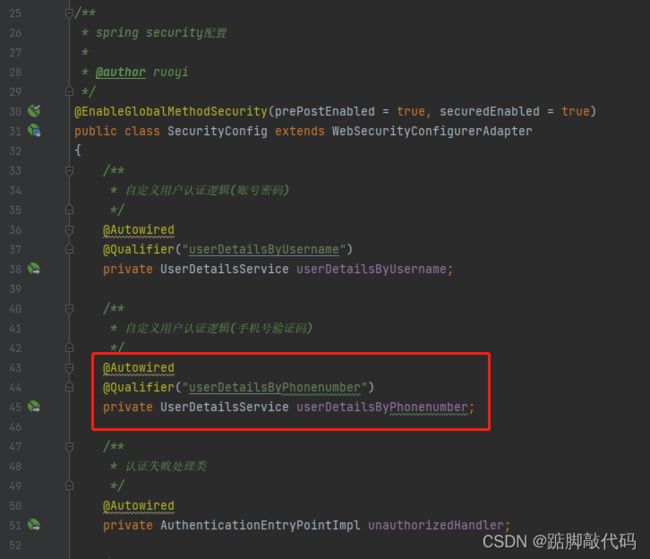若依RuoYi整合短信验证码登录
背景:若依默认使用账号密码进行登录,但是咱们客户需要增加一个短信登录功能,即在不更改原有账号密码登录的基础上,整合
短信验证码登录。
本名案例基于RuoYi-Vue版本实现,其他版本应该大同小异。
一、自定义短信登录 token 验证
仿照 UsernamePasswordAuthenticationToken 类,编写短信登录 token 验证。
package com.ruoyi.framework.security.authentication;
import org.springframework.security.authentication.AbstractAuthenticationToken;
import org.springframework.security.core.GrantedAuthority;
import org.springframework.security.core.SpringSecurityCoreVersion;
import java.util.Collection;
/**
* 自定义短信登录token验证
*/
public class SmsCodeAuthenticationToken extends AbstractAuthenticationToken {
private static final long serialVersionUID = SpringSecurityCoreVersion.SERIAL_VERSION_UID;
/**
* 存储手机号码
*/
private final Object principal;
/**
* 构建一个没有鉴权的构造函数
*/
public SmsCodeAuthenticationToken(Object principal) {
super(null);
this.principal = principal;
setAuthenticated(false);
}
/**
* 构建一个拥有鉴权的构造函数
*/
public SmsCodeAuthenticationToken(Object principal, Collection<? extends GrantedAuthority> authorities) {
super(authorities);
this.principal = principal;
super.setAuthenticated(true);
}
@Override
public Object getCredentials() {
return null;
}
@Override
public Object getPrincipal() {
return this.principal;
}
@Override
public void setAuthenticated(boolean isAuthenticated) throws IllegalArgumentException {
if (isAuthenticated) {
throw new IllegalArgumentException(
"Cannot set this token to trusted - use constructor which takes a GrantedAuthority list instead");
}
super.setAuthenticated(false);
}
@Override
public void eraseCredentials() {
super.eraseCredentials();
}
}
二、编写 UserDetailsService 实现类
在用户信息库中查找出当前需要鉴权的用户,如果用户不存在,loadUserByUsername() 方法抛出异常;如果用户名存在,将用户信息和权限列表一起封装到 UserDetails 对象中。
package com.ruoyi.system.service.impl;
import com.ruoyi.common.core.domain.entity.SysUser;
import com.ruoyi.common.core.domain.model.LoginUser;
import com.ruoyi.common.enums.UserStatus;
import com.ruoyi.common.exception.ServiceException;
import com.ruoyi.common.utils.StringUtils;
import com.ruoyi.system.service.ISysUserService;
import com.ruoyi.system.service.SysPermissionService;
import org.slf4j.Logger;
import org.slf4j.LoggerFactory;
import org.springframework.beans.factory.annotation.Autowired;
import org.springframework.security.core.userdetails.UserDetails;
import org.springframework.security.core.userdetails.UserDetailsService;
import org.springframework.security.core.userdetails.UsernameNotFoundException;
import org.springframework.stereotype.Service;
/**
* 用户验证处理
*
* @author hjs
*/
@Service("userDetailsByPhonenumber")
public class UserDetailsByPhonenumberServiceImpl implements UserDetailsService {
private static final Logger log = LoggerFactory.getLogger(UserDetailsByPhonenumberServiceImpl.class);
@Autowired
private ISysUserService userService;
@Autowired
private SysPermissionService permissionService;
@Override
public UserDetails loadUserByUsername(String phoneNumber) throws UsernameNotFoundException {
// 防止漏查角色等所需的信息,尽量模仿根据用户名查用户的方法开发:ISysUserService.selectUserByUserName(username)
SysUser user = userService.selectUserByPhonenumber(phoneNumber);
if (StringUtils.isNull(user)) {
log.info("登录用户:{} 不存在.", phoneNumber);
throw new ServiceException("登录用户:" + phoneNumber+ " 不存在");
} else if (UserStatus.DELETED.getCode().equals(user.getDelFlag())) {
log.info("登录用户:{} 已被删除.", phoneNumber);
throw new ServiceException("对不起,您的账号:" + phoneNumber+ " 已被删除");
} else if (UserStatus.DISABLE.getCode().equals(user.getStatus())) {
log.info("登录用户:{} 已被停用.", phoneNumber);
throw new ServiceException("对不起,您的账号:" + phoneNumber+ " 已停用");
}
return createLoginUser(user);
}
public UserDetails createLoginUser(SysUser user) {
return new LoginUser(user.getUserId(), user.getDeptId(), user, permissionService.getMenuPermission(user));
// return new LoginUser(user, permissionService.getMenuPermission(user));
}
}
您们后台的框架很有可能被您的上师或者以前的老员工优化处理过,为了防止漏查角色等权限所需的信息,因此您在查询用户(userService.selectUserByPhonenumber(phoneNumber))时,尽可能模仿账号密码登录的代码(ISysUserService.selectUserByUserName(username)),包含SQL,返回对应的数据;测试阶段最好在创建用户(createLoginUser)方法内加个异常捕捉;防止抛了异常却没有捕捉,导致浪费大量时间精力排查。
评论区很多小伙伴都在这里踩雷了,因此特显标志。
三、自定义短信登录身份认证
在 Sping Security 中因为 UserDetailsService 只提供一个根据用户名返回用户信息的动作,其他的责任跟他都没有关系,怎么将 UserDetails 组装成 Authentication 进一步向调用者返回呢?其实这个工作是由 AuthenticationProvider 完成的,下面我们自定义一个短信登录的身份鉴权。
-
自定义一个身份认证,实现 AuthenticationProvider 接口;
-
确定 AuthenticationProvider 仅支持短信登录类型的 Authentication 对象验证;
-
1、重写 supports(Class authentication) 方法,指定所定义的 AuthenticationProvider 仅支持短信身份验证。
-
2、重写 authenticate(Authentication authentication) 方法,实现身份验证逻辑。
package com.ruoyi.framework.security.authentication;
import com.ruoyi.framework.security.authentication.SmsCodeAuthenticationToken;
import org.springframework.security.authentication.AuthenticationProvider;
import org.springframework.security.core.Authentication;
import org.springframework.security.core.AuthenticationException;
import org.springframework.security.core.userdetails.UserDetails;
import org.springframework.security.core.userdetails.UserDetailsService;
/**
* 自定义短信登录身份认证
*/
public class SmsCodeAuthenticationProvider implements AuthenticationProvider {
private UserDetailsService userDetailsService;
public SmsCodeAuthenticationProvider(UserDetailsService userDetailsService){
setUserDetailsService(userDetailsService);
}
/**
* 重写 authenticate方法,实现身份验证逻辑。
*/
@Override
public Authentication authenticate(Authentication authentication) throws AuthenticationException {
SmsCodeAuthenticationToken authenticationToken = (SmsCodeAuthenticationToken) authentication;
String telephone = (String) authenticationToken.getPrincipal();
// 委托 UserDetailsService 查找系统用户
UserDetails userDetails = userDetailsService.loadUserByUsername(telephone);
// 鉴权成功,返回一个拥有鉴权的 AbstractAuthenticationToken
SmsCodeAuthenticationToken authenticationResult = new SmsCodeAuthenticationToken(userDetails, userDetails.getAuthorities());
authenticationResult.setDetails(authenticationToken.getDetails());
return authenticationResult;
}
/**
* 重写supports方法,指定此 AuthenticationProvider 仅支持短信验证码身份验证。
*/
@Override
public boolean supports(Class<?> authentication) {
return SmsCodeAuthenticationToken.class.isAssignableFrom(authentication);
}
public UserDetailsService getUserDetailsService() {
return userDetailsService;
}
public void setUserDetailsService(UserDetailsService userDetailsService) {
this.userDetailsService = userDetailsService;
}
}
四、修改 SecurityConfig 配置类
4.1 添加 bean 注入
4.2 身份认证方法加入手机登录鉴权
五、发送短信验证码
/**
* 发送短信验证码接口
* @param phoneNumber 手机号
*/
@ApiOperation("发送短信验证码")
@PostMapping("/sendSmsCode/{phoneNumber}")
public AjaxResult sendSmsCode(@PathVariable("phoneNumber") String phoneNumber) {
// 手机号码
phoneNumber = phoneNumber.trim();
// 校验手机号
SysUser user = sysUserService.selectUserByPhonenumber(phoneNumber);
if (StringUtils.isNull(user)) {
throw new ServiceException("登录用户:" + phoneNumber+ " 不存在");
}else if (UserStatus.DELETED.getCode().equals(user.getDelFlag())) {
throw new ServiceException("对不起,您的账号:" + phoneNumber+ " 已被删除");
}else if (UserStatus.DISABLE.getCode().equals(user.getStatus())) {
throw new ServiceException("对不起,您的账号:" + phoneNumber+ " 已停用");
}
/**
* 省略一千万行代码:校验发送次数,一分钟内只能发1条,一小时最多5条,一天最多10条,超出提示前端发送频率过快。
* 登录第三方短信平台后台,康康是否可以设置短信发送频率,如果有也符合业务需求可以不做处理。
*/
// 生成短信验证码
String smsCode = "" + (int)((Math.random()*9+1)*1000);
// 发送短信(实际按系统业务实现)
SmsEntity entity = new SmsEntity(phoneNumber, smsCode);
SendMessage.sendSms(entity);
if(entity==null || !SmsResponseCodeEnum.SUCCESS.getCode().equals(entity.getResponseCode())){
throw new ServiceException(entity.getResponseDesc());
}
// 保存redis缓存
String uuid = IdUtils.simpleUUID();
String verifyKey = SysConst.REDIS_KEY_SMSLOGIN_SMSCODE + uuid;
redisCache.setCacheObject(verifyKey, smsCode, SysConst.REDIS_EXPIRATION_SMSLOGIN_SMSCODE, TimeUnit.MINUTES);
/**
* 省略一千万行代码:保存数据库
*/
AjaxResult ajax = AjaxResult.success();
ajax.put("uuid", uuid);
return ajax;
}
六、手机验证码登录接口
/**
* 短信验证码登录验证
* @param dto phoneNumber 手机号
* @param dto smsCode 短信验证码
* @param dto uuid 唯一标识
*/
@ApiOperation("短信验证码登录验证")
@PostMapping("/smsLogin")
public AjaxResult smsLogin(@RequestBody @Validated SmsLoginDto dto) {
// 手机号码
String phoneNumber = dto.getPhoneNumber();
// 校验验证码
String verifyKey = SysConst.REDIS_KEY_SMSLOGIN_SMSCODE + dto.getUuid();
String captcha = redisCache.getCacheObject(verifyKey);
if(captcha == null) {
AsyncManager.me().execute(AsyncFactory.recordLogininfor(phoneNumber, Constants.LOGIN_FAIL, MessageUtils.message("user.jcaptcha.expire")));
// 抛出一个验证码过期异常
throw new CaptchaExpireException();
}
if(!captcha.equals(dto.getSmsCode().trim())){
AsyncManager.me().execute(AsyncFactory.recordLogininfor(phoneNumber, Constants.LOGIN_FAIL, MessageUtils.message("user.jcaptcha.error")));
// 抛出一个验证码错误的异常
throw new CaptchaException();
}
redisCache.deleteObject(verifyKey);
// 用户验证
Authentication authentication = null;
try {
// 该方法会去调用UserDetailsByPhonenumberServiceImpl.loadUserByUsername
authentication = authenticationManager.authenticate(new SmsCodeAuthenticationToken(phoneNumber));
} catch (Exception e) {
if (e instanceof BadCredentialsException) {
AsyncManager.me().execute(AsyncFactory.recordLogininfor(phoneNumber,
Constants.LOGIN_FAIL, MessageUtils.message("account.not.incorrect")));
throw new UserPasswordNotMatchException();
} else {
AsyncManager.me().execute(AsyncFactory.recordLogininfor(phoneNumber,
Constants.LOGIN_FAIL, e.getMessage()));
throw new ServiceException(e.getMessage());
}
}
// 执行异步任务,记录登录信息
AsyncManager.me().execute(AsyncFactory.recordLogininfor(phoneNumber,
Constants.LOGIN_SUCCESS, MessageUtils.message("user.login.success")));
// 获取登录人信息
LoginUser loginUser = (LoginUser) authentication.getPrincipal();
// 修改最近登录IP和登录时间
recordLoginInfo(loginUser.getUserId());
// 生成token
String token = tokenService.createToken(loginUser);
// 返回token给前端
AjaxResult ajax = AjaxResult.success();
ajax.put(Constants.TOKEN, token);
return ajax;
}
大功告成!创作不容易,若对您有帮助,欢迎收藏 。
点赞点赞点赞一定要点赞

